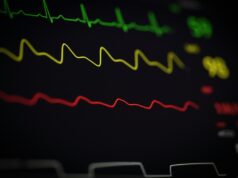
Healthcare professionals should include 14 key elements that can be used as a checklist for screening young people age 12–25 for congenital and genetic heart disease. If any of the elements are positive, further testing may be needed, but initial screening using electrocardiograms (ECGs) to detect underlying genetic and congenital heart disease in this age group prior to employing this checklist, has not been shown to save lives, according to a joint American Heart Association (AHA)/American College of Cardiology (ACA) statement.
“Although sudden death among young people is rare, it is always a tragedy, and the infrequency of these events in no way mitigates their importance or impact on families and the community. However, the media coverage of sudden cardiac arrests in athletes may have created the exaggerated impression that these tragic events are far more common than they actually are, or that they are limited to athletes,” says Barry J Maron, chair of the writing panel for the statement and director of the Hypertrophic Cardiomyopathy Center at the Minneapolis Heart Institute Foundation, Minneapolis, USA.
The statement, published simultaneously in Circulation and the Journal of the American College of Cardiology, notes that broader dissemination of automatic external defibrillators (AEDs) in public gathering places, such as sports arenas and schools, can be highly effective in saving young lives on the athletic field or elsewhere, when cardiac arrest does occur.
There is no evidence that sudden cardiac arrest is more common in athletes than in the general population of young people, and the authors advise healthcare providers to use the 14-element checklist when screening or evaluating young people 12–25 years of age for underlying congenital or genetic cardiovascular heart disease.
“Those who do not sign up for sports are just as likely to have the genetic heart diseases that raise the risk for sudden death,” Maron says.
“Since there are by far more non-athletes-only about 1% of college students and 30% of high school students participate in competitive sports-there are more deaths in non-athletes participating in recreational sports and normal daily activities,” Maron notes.
Twelve-lead ECGs record the electrical activity of the heart and may in some cases detect congenital heart disease that can lead to sudden cardiac death. They should be used when a healthcare provider has determined a young person may be at higher risk for a heart abnormality based on family history, physical examination and other parts of the 14-element questionnaire. The healthcare provider may find that other tests, such as echocardiograms, would be helpful in some individuals as well.
Rare cases of seemingly healthy young people dying while playing sports have led to calls for legislation in some countries to mandate that all athletes be screened with an ECG. However, the expert panel convened by the American Heart Association and American College of Cardiology, which reviewed publications from those other countries as well as data from the United States, concluded that primary ECG screening would not be effective for healthy young people in the USA, due to several concerns, including false negative or false positive test results that may either fail to detect an underlying heart problem or incorrectly suggest that one is present when the heart is healthy. False positive ECG tests appear to be more likely in African-Americans. And the profile of the cardiovascular disorders that cause sudden cardiac death appears to vary considerably between countries.
The primary reason for not mandating screening of either competitive athletes or the general young US population with a 12-lead ECG is that there is currently insufficient evidence to conclude that it would save lives if it was used as a universal screening tool. In addition, the value of the test varies based on the expertise of those interpreting the test. Assessing paediatric ECGs can be particularly difficult, because the ECG changes with growth and development, and the expertise required is not widely available.
While the greatest concern is to prevent the tragedy of sudden cardiac death, one must also consider the cost. Implementing mandatory screening for athletes alone would require that 10 million individuals be screened for relatively rare disorders. The overall cost for such a programme is estimated to be at least US$2 billion a year to start, and somewhat less annually thereafter. In addition, it would be necessary to develop an infrastructure of testing centres and experts to read the ECGs, as well as creating uniform criteria for interpreting paediatric ECGs. Many individuals at high risk for sudden cardiac death could be found by more uniform application of careful history taking and a detailed physical examination (without an ECG) utilised in all.
The 14-element screening checklist for this process recommends assessing young people for findings on the physical examination, including heart murmurs, and for any history of unexplained fainting, exertional chest pain, or excessive shortness of breath or fatigue during exercise; family history includes questions about a history of premature death or disability due to heart disease or known cardiac conditions involving the heart muscle or heart rhythm before age 50 in one or more family members. Since the 2007 12-item checklist was suggested, two additional questions have been added-asking if an individual has been restricted from participation in sports in the past or has had prior testing for the heart, ordered by a healthcare provider.












